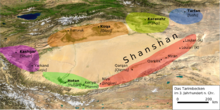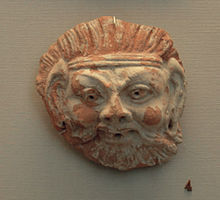Kingdom of Hotan
The Kingdom of Hotan was a Buddhist kingdom on the Silk Road that existed from the first to the tenth centuries AD. The empire and its capital Hotan (Khotan), which is essentially an oasis city , are located in the northwest of today 's People's Republic of China . The area was formerly known as "Chinese Turkestan".
history

The early history of Khotan is dark; later, Buddhist legends are of no historical significance. The kingdom of Khotan first appears in Chinese sources around the birth of Christ. It is reported that a Khotanese embassy visited the Chinese court under Wudi . At that time, Khotan already dominated parts of the western Tarim Basin , King Guangde ( 廣 德 , Guǎngdé) even conquered Yarkand in AD 61 . However, Hotan was threatened by the expanding Xiongnu , which is why, at Guangde's request, the Chinese general Ban Chao drove the Xiongnu out in 73 and 74. A Chinese governor has now been installed in this area . The Kingdom of Hotan became a kind of vassal state of China, but as a location on the Silk Road it played an important role in mediating between East and West.
In the 3rd century, according to the Weilüe report, Khotan still ruled several kingdoms in the southwestern Tarim Basin. In the 5th century, a Sassanid ruler sent gifts to China via Hotan. Envoys at the Chinese court reported several times. Culturally, the empire combined influences from Iran , India and China. The Chinese pilgrims Faxian (c. 337-422), Songyun (c. 520) and Xuanzang (603-664), who visited Hotan on their travels, described it as a rich country with several Buddhist monasteries .
In the 6th century the empire became a vassal of the Hephthalites (the so-called White Huns ) and after the destruction of their empire (around 560) it became dependent on the Gök Turks . In the Tang Dynasty , China's interest in the Tarim Basin increased again, which is why a Chinese garrison was stationed in Khotan in 648 as part of the " Four Garrisons of Anxi ". In 670 Khotan fell briefly under Tibetan rule, which was then replaced by China around 700, before it was re-conquered by the Tibetans around 790. In the following years Khotan was hit by the general decline of the Tarim Basin.
In the middle of the 9th century, Uyghurs who migrated west after the fall of their kaganat came and established a kingdom in Kocho that encompassed the eastern Tarim Basin, including Khotan. The state religion was Manichaeism brought with them by the Uyghurs, and the Turkicization of the area continued.
In 1006 the empire of Hotan was finally conquered by the Muslims and finally fell.
art
The art in the Kingdom of Hotan, like many city-states on the Silk Road, is of particular importance as it brings together eastern and western elements. It is mainly shaped by Buddhism .
The architecture is best known for its Buddhist monasteries. Rawak Vihara was a monastery town. Here was a stupa that was once probably 12 m high. It is built on a broad square platform. A staircase leads up on each side. A cross-shaped floor plan was created. The whole building was in a 50 × 44 m enclosure. This perimeter wall was richly decorated with stucco sculptures of Buddhas . The whole building shows a strong western influence. The floor plan of the stupa is similar to comparable buildings in Peshawar and Afghanistan . The same goes for the plastic found here. A Buddha head, which is now in New York, is said to come from here and seems identical to those from the area of Gandhara art, which in turn is strongly influenced by Hellenism.
In the monastery near Dandan Uilik there were many paintings that again show a strong Indian influence.
See also
literature
- BA Litvinsky et al. a. (Ed.): History of civilizations of Central Asia, Volume III. The crossroads of civilizations: AD 250 to 750 . Paris 1996.
- Marianne Yaldız : Archeology and Art History of Sino-Central Asia (Xinjiang) . Leiden 1987, especially p. 182ff.
- Marylin M. Rhie: Early Buddhist Art of China and Central Asia (Handbook of Oriental Studies / Handbuch der Orientalistik - Part 4: China, 12, Vol. 1) (Handbook of Oriental Studies / Handbuch der Orientalistik) . Brill Academic Publishers, Leiden 1999, ISBN 90-04-11201-4
Web links
Individual evidence
- ↑ Max Meyerhof: Persian Turkish Mysticism. Orient-Buchhandlung Heinz Lafaire, Hannover 1921, p. 25

